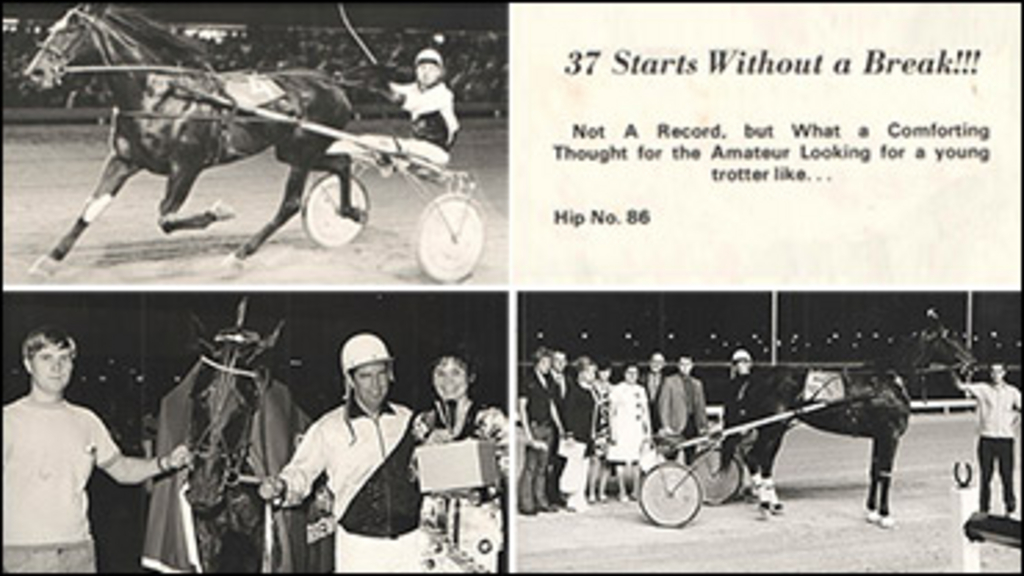
In the latest edition of 'Rewind,' Robert Smith recalls a great performer from the years surrounding 1970. Aunt Penny was a bargain-priced trotting mare that brought much joy to her owner and the legion of fans that she attracted in her very successful racing career. Despite the passage of nearly 50 years since her purchase, the memories abound with her longtime owner. I am pleased that he recently shared her story with me.
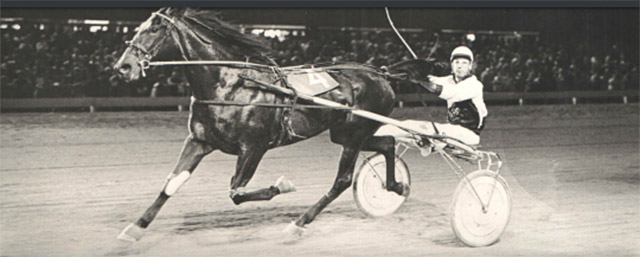
Aunt Penny trots flawlessly to the wire at Garden City a winner for driver Bill Stirton and owner Dr. John McKnight in this 1970 photo. She was a consistent performer for a number of years on the tough O.J.C. circuit competing in the popular weekly Invitationals.
Back in 1968 a then rather young farmboy from up in the Georgian Bay area of Ontario near Meaford was just embarking on his professional career. John McKnight had just added the prefix "Dr." to his name as he graduated from veterinary school at Guelph. His dreams were undoubtedly many but none of them included the ownership of a standardbred horse; in fact nothing could have been further from his mind. Things can change.
Soon after his 1968 graduation the young "Doc" accepted a position with Dr. Murray Dudgeon of Orangeville, Ont., working in the mixed animal practice at Dufferin Veterinary Services. Dr. Dudgeon was a horse enthusiast but his interest was mainly in the direction of thoroughbreds. Somehow the clinic evolved into the local Turf Club, albeit unofficially. Accordingly the "horsey" atmosphere was conducive to a lot of free input from the locals in the evenings or for that matter whenever they showed up. Dr. McKnight recalls "it was not unusual to have nine or ten sitting around telling tall racing stories. At about that time Mohawk was still a fairly new track, Barrie was not too far off of start up and of course a developing track in Orangeville was part of the local scene."
By this time Bill Stirton, a former butcher turned local horse trainer, had already developed a reputation for spotting a cheap horse that he could improve on; Silver Nib Lee being his first such success story. His general plan was to buy three-year-olds who had raced primarily in the Ohio, Pennsylvania or New York stakes and develop them into aged performers. Suffice it to say that those long ago series would not compare to today's programs but they were still a good proving ground.
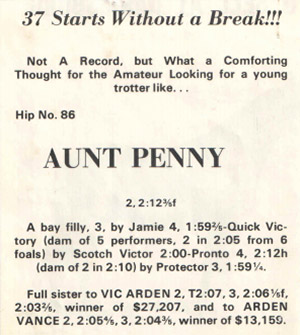
An ad for the upcoming sale of Aunt Penny that appeared in the Harness Horse magazine in 1969. Her ability to stay trotting without breaking remained throughout her career as she made just one break and that was caused by interference.
Dr. McKnight recalls how it all started for him and his interest in becoming a racehorse owner. "I soon became enthused to the point of discussing my thoughts with Bill. When the 1969 Harrisburg Mixed Sale came up I accompanied him, Tom Lockyer and a couple of others to try my luck. My goal was to buy an inexpensive trotting mare that I might be able to race locally. Back then you could not acquire a mixed sale catalogue prior to arrival so all the decisions had to be made onsite and with trust in the seller."
John had a few possibilities in mind but the one prospect he was mainly interested in was a trotting mare sired by Jamie, named Aunt Penny. She had started 37 times at two and three and showed lifetime earnings of $3,500 with a mark of 2:12f taken at two with noted horseman Harry Harvey driving. Those statistics were somewhat short of startling but she did possess another redeeming trait. She had never made a break and that fact had been publicized in a rather large ad leading up to the sale. While her current trainer was listed as Harry Harvey she had actually been mainly raced by her owner, a used car dealer in Pennsylvania. This gentleman was somewhat of an amateur reinsman and he loved to drive her whenever he could at the local fairs. He apparently used a moniker "Aunt Penny" in his radio ads when advertising the used car of the week, thus the genesis of her name.
"One part of the plan that was firm was my spending limit. I made it clear to Bill that $1,500 was my absolute limit. Just out of Vet College I had student loans and a car loan and wasn't looking for more financial responsibilities. We decided to bid on her and once she got to $1,500 I said I'm out! Stirton being an extreme optimist urged me to make another bid, assuring me that she would soon pay for herself. He also offered to withhold his fees until she started earning money. The hammer dropped at $2,100 and I was a horse owner much to the chagrin of my parents and many others who were sure I had lost my mind." In time they would become Aunt Penny's biggest fans and supporters.
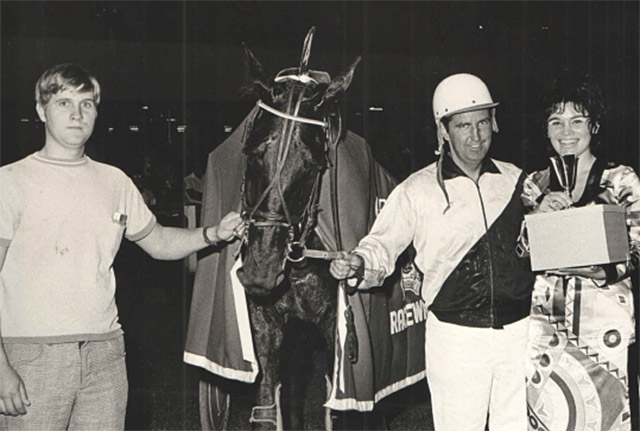
Aunt Penny takes a slight bow in the Garden City winner's circle following one of her many victories. Driver Bill Stirton and assistant trainer Tim Keeling accept congratulations from the presenting hostess. John McKnight recalls that even though it was a three-hour trip home from Garden City it never seemed long when you had a winner.
Fast forward to her racing career back home on the tough O.J.C. circuit. After about ten starts in 1970 she was racing with some of the best trotters around. John recalls "She raced against some tough competitors -- Claybrook Van, Gayest Hanover, Beau Winter, Fearless Doc, Cadenza, Proud Vic, Paula N and even Fresh Yankee to name just a few." It could probably best be described as a Cinderella story as she made her way through that 1970 season. Virtually out of local competition she ended the season at Batavia where Murray Waples catch drove her to two more victories. Her season's earnings reached $48,000 which in today's dollars would be $301,000. What a first season!
In late 1972 Dr. McKnight decided to make an attempt at a faster record for Aunt Penny. He made arrangements with the famous Joe O'Brien to train and race her out in California with hopes of a sub-2:00 mile which would enhance her broodmare status. The plan, while well-conceived ended up pretty much a total failure. Soon after she arrived in Lexington, O'Brien was seriously injured and was never able to enact the plan as he was barely able to sit behind her. She did make the trip to California but did not do all that well and for sure did not take a new speed record.
At around this time Dr. McKnight also made a career change which fully immersed him into the world of harness racing. In 1971 he was hired on a full-time basis by the globally famous Armstrong Farm at Brampton where he would spend the better part of two decades working with a large number of standardbreds. John recently said "It was a great opportunity and learning experience. While there, I absorbed some great life and business lessons from Elgin and Ted Armstrong which have been valuable guidelines to me ever since."

Dr. John McKnight (directly behind horse next to driver Bill Stirton) and several family members enjoy a trip to the Garden City winner's circle to celebrate another win by Aunt Penny.
She ended her racing career at age six with earnings of $105,000, a record of 2:03.4f and was bred to the freshly-retired Super Bowl. Her breeding career was, to say the least, unspectacular. Her first Super Bowl filly was born with a club foot, was unraced however did produce a colt called Performance Plus, a decent Ont. sired trotter. She had two more non-descript fillies incurring some reproductive damage foaling the third, thus putting an end to her breeding career. She lived out her 22 years and is buried on the generational family farm she helped pay for at Meaford.
In the way of a closing remark Dr. McKnight recently summed up his feelings as follows.
"A totally different era and what a way for a guy to start. It wasn’t long until I realized she was actually a bit of a fluke — never to be repeated. I know that I will never duplicate the thrills of a first-time owner she gave me. Aunt Penny was somewhat of a serendipitous event in my life."
Who is it?
Over the years people who have served on boards and committees have done a great deal to improve and promote our sport as well as those who engage in actual competition. The above photo from 24 years ago includes a number of well-known personalities who served on the early S.B.O.A. board.
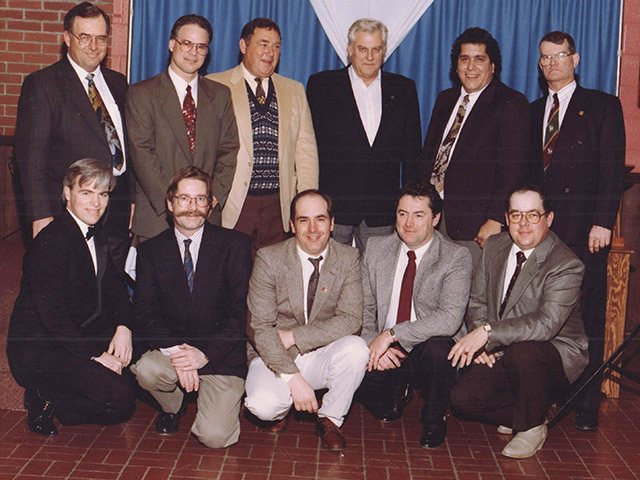
Can you put a name on each one of the eleven? The correct answers will be given during the coming week.


Bill Stirton was my Dad. I
Bill Stirton was my Dad. I was delighted when a friend directed me to your publication and to this particular article featuring my Dad. There were many horses that he did well with and was talented at training pacers to "trot". He truly had the magic touch. I remember John well - it was lovely to go down memory lane today. Thanks for your article.
As usual a lovely trip down
As usual a lovely trip down memory lane. You continue to post articles that make me proud that I love this sport of harness racing. Aunt Penny was special.
Thanks to Mr. Foerster for
Thanks to Mr. Foerster for his understandable accuracy on this week's group photo. The eleven gentlemen in this week's photo were exactly as identified by Gary as follows:
Front Row (L-R) - Greg Unger, Jim Gillies, Bill McElroy, John McKnight, John Poole
Back Row (L-R) - Chris Van Bussel, Hugh Mitchell, Harry Rutherford, Tom Lockyer, Joe Miskokomon, Don McNiven
John McKnight was a great
John McKnight was a great friend, contributor and supporter of The Canadian Sportsman, as were many in this photo, and I will always be grateful for their support.
Back Row, (l to r): Chris Van Bussel, Hugh Mitchell, Harry Rutherford, Tom Lockyer, Joe Miskokomon, Don McNiven
Front Row, (l to r): Greg Unger, Jim Gillies, Bill McElroy, John McKnight, John Poole
The following note was
The following note was received from Tim Keeling re this week's Rewind:
I read your Rewind every Saturday and was very surprised to see myself and the late Bill Stirton in your article. Actually, one of my friends from Winnipeg called me to tell me about it before I had a chance to read it. If I can be of any assistance to you in future please don't hesitate to contact me. I have many old photos from the 60's through to the early 90's. Thanks, and I will look forward to your future articles.
Tim
Wm Stirton was my uncle and I
Wm Stirton was my uncle and I well remember "Aunt Penny" and "Silver Nib Lee". My Uncle did seem to have some magic with trotters. Tim Keeling are you still around?
We went to Thornbury last
We went to Thornbury last Sunday for dinner. On our way we drove by Dr. McKinght’s farm. It is a beautiful farm up on a hill just south of Meaford over looking Georgian Bay.
What a great article!
What a great article!